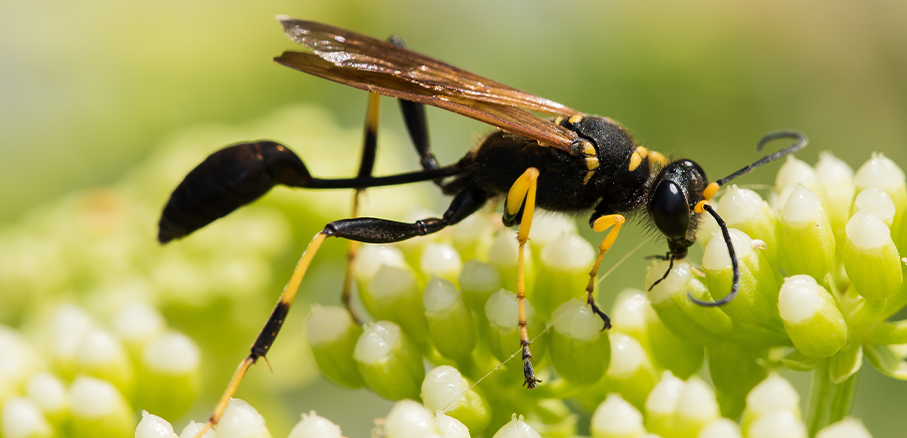Getting Rid of Mud Dauber Nests

All it takes is a solitary stinging insect buzzing by to send an entire picnic party scattering in all directions. Pests can put a serious wrench in your outdoor plans, and the wasp-like insects known as mud daubers are no exception.
Unwanted insects are never on the guest list, so read on to learn how to identify these flying insects and keep them at a more comfortable distance.
HOW CAN I SPOT A MUD DAUBER?
Mud daubers, also known as mud wasps, are members of the wasp family, so a quick glance might have you classifying them as the more widely known yellow jackets, paper wasps, hornets, or even bees.
Mud daubers have the characteristic wings, antennae, and six legs of their wasp cousins, but they’re often larger in size and have a more metallic luster. Mud daubers themselves can vary in color. Many of these stinging insects have black and yellow markings similar to wasps, while others have primarily bluish-black bodies. The most telling trait of a mud dauber, however, is the thin, thread-like waist connecting its abdomen and thorax.
The first indication of nearby mud daubers isn’t always an in-the-flesh sighting. It’s often the presence of its characteristic mud nest. Mud daubers construct their chambered nests from clay and mud they gather in moist areas. These nests vary in appearance, from complex tube-like structures to simple “plastered” gaps and cracks in buildings. Mud daubers are not hive-minded or social insects, and a single female will lay her eggs within a nest of her own construction in sheltered areas away from view.
WHERE ARE MUD DAUBERS COMING FROM?
Mud daubers are drawn to locations that have access to mud which they use to craft their nests, as well as to areas with an abundance of smaller spiders and insects to feast upon.
Unlike other aggressive insects, they’re unlikely to sting defensively unless roughly touched or caught. The venom in their stingers is instead reserved for immobilizing their prey. Mud dauber females catch and paralyze spiders and insects, pack their nest cells with the paralyzed prey, and lay their eggs inside so their offspring will have a quick meal upon hatching.
Nests are often located in places with a lot of human activity. They’re frequently found in sheltered areas where mud is likely to stick, such as on urban buildings, eaves of homes, under bridges, and even underneath or inside the engines of cars or airplanes. Mud dauber nests are largely considered an aesthetic nuisance at worst, but if left abandoned, the nests can be overtaken by more dangerous wasp species or other pests feasting on any leftover meals inside the nest.
HOW CAN I GET RID OF MUD DAUBERS?
To remove mud daubers and prevent them from coming back, you’ll need to eliminate the pests they feed on and remove mud dauber nests.
Eliminate the Pests They Feed On
The first step in banishing mud daubers should be to take on the small insects and spiders that are attracting them to the area. Start with pest control that is designed to eliminate spider populations by removing spiderwebs, sweeping corners and crevices, and sealing up cracks and areas spiders could potentially congregate. Sealing up those cracks and crevices will not only discourage spiders, but it will also discourage mud daubers from nesting in those areas as well.
Mud dauber stings are about as painful as a bite from a fire ant, but they’re not dangerous, poisonous, or fatal. These insects are venomous, however, and can cause the same unpleasant or dangerous reaction in anyone allergic to bee or wasp venom. If you spot a mud dauber and want to avoid a sting, it’s best to leave it alone and carry on elsewhere, creating a safe distance if you’d like to be cautious.
Remove Mud Dauber Nests
If you’d like to take further measures to safeguard yourself from mud dauber stings, remove their nests to deter their return. This will also restrain future mud dauber populations. Be cautious, however—manual removal of a mud dauber nest must be done carefully.
An older and possibly abandoned nest will have small exit holes where maturing mud daubers first emerged to take flight into the world, but such a nest might also be filled with more aggressive stinging insects who have taken residence inside the nest. The nest can be removed or relocated at night (when the pests are more docile) using gloves and a paint scraper, but to be certain it’s done safely, a call to a pest control professional might be in order.
WHEN WILL MY YARD BE FREE OF MUD DAUBERS?
Mud daubers are beneficial to many homeowners, as they’re excellent at reducing spider populations and are not considered to be aggressive invaders. However, pests of any kind can be an annoyance, disrupt the peace for those afraid of flying insects, and be a serious danger to those with a wasp-venom allergy.
Sealing up potential nesting sites, reducing spider populations, and relocating or removing the nests should reduce the problem in no time, but if mud daubers insist on sticking around, it may be time to pick up the phone and bring in the pros.
Give us a call to talk with a pest control professional about nest removal or to discuss what next steps are available to you to effectively banish mud daubers from your home and garden for good.





